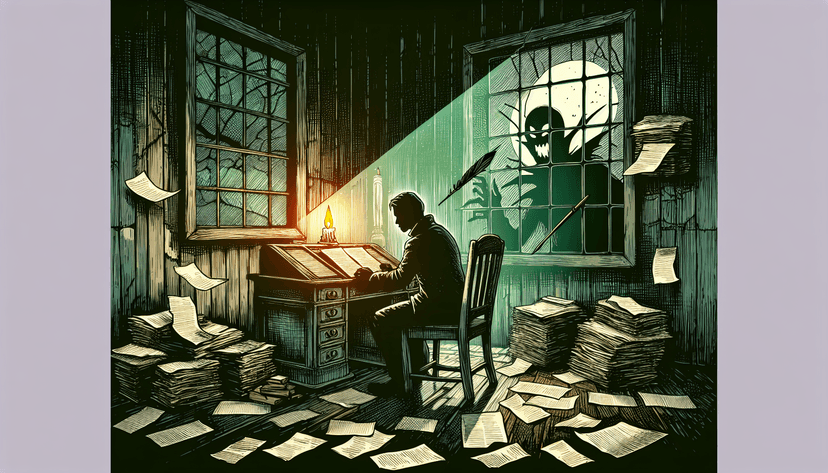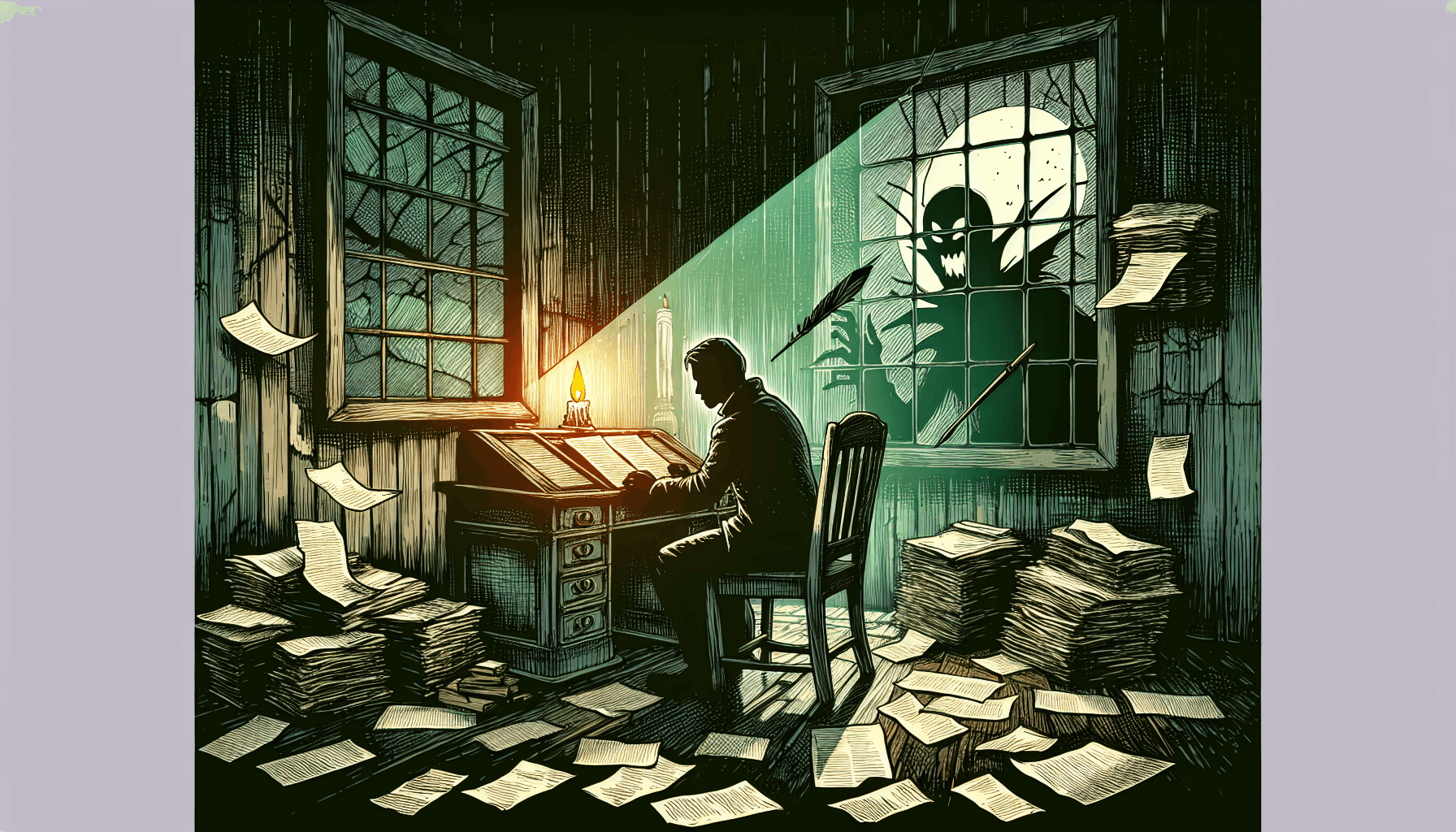Table of Contents
Writing a horror short story can feel daunting, right? With so many elements to juggle—characters, atmosphere, and fear—you might wonder where to even start. You’re not alone; many aspiring writers find themselves staring blankly at a page, haunted by the fear of failure.
But fear not! If you stick around, I’m here to guide you through the essentials of crafting that spine-chilling tale. By breaking it down into manageable steps, you’ll learn how to build tension, create gripping characters, and master the art of suspense.
We’ll touch on everything from choosing a central theme to crafting a satisfying conclusion. So grab your favorite snack, dim the lights, and let’s get started on making those readers jump!
Key Takeaways
- Choose a central theme that resonates and guides your horror story.
- Create relatable, flawed characters that evoke sympathy and tension.
- Build suspenseful atmosphere using vivid descriptions and sensory details.
- Structure your story with a strong beginning, middle, and end for engagement.
- Incorporate elements of fear through pacing, foreshadowing, and unexpected twists.
- Craft an intense climax where tension peaks and character choices matter.
- End with a memorable conclusion, leaving readers with lingering thoughts and emotions.
- Edit ruthlessly, focusing on structure, pacing, and refining language.
- Gather feedback from others to refine your story based on their reactions.
- Be open to revision and use tools for final proofreading before sharing.

Step 1: Decide on a Central Theme for Your Horror Story
The first thing you need to do is pick a central theme that resonates with your audience. Think of what scares you and what elements of horror intrigue you. Common themes include fear of the unknown, isolation, and confronting death. Once you’ve settled on a theme, it will guide your story’s direction and help maintain focus. For example, if you choose the theme of isolation, consider placing your characters in a remote location like an abandoned cabin or desolate wasteland.
Step 2: Create Compelling Characters
Your characters are the heart of your story—they drive the plot and evoke empathy from readers. Start by fleshing out their backgrounds, fears, and motivations. Aim for a mix of relatable characters and archetypes; this creates tension when facing supernatural threats. Also, consider giving your protagonists flaws that make them vulnerable, making viewers root for their survival. For instance, a character struggling with anxiety might have a panic attack when faced with danger, making them relatable and real.
Step 3: Build a Suspenseful Atmosphere
Atmosphere is crucial in horror; it sets the mood and can amplify fear. Use descriptive language to paint vivid scenes that make readers feel they are in the story. Dark, eerie settings can enhance suspense, so don’t be afraid to include weather elements like thunderstorms or fog. Consider using sensory details: describe not just what the characters see, but also what they hear, smell, and feel. For inspiration, check out examples of chilling openings from classic horror literature, which can be effective for setting the tone.

Step 4: Structure Your Story with a Strong Beginning, Middle, and End
A well-structured story keeps readers engaged from start to finish. Begin with a hook that grabs attention immediately—this might be a shocking event or a chilling atmosphere.
In the middle, you should develop your plot by adding layers of conflict, escalating tension, and deepening character development.
Finally, the end must resolve the story’s conflicts while leaving readers with a satisfying conclusion or a lingering feeling of dread.
Consider using classic storytelling structures, such as the three-act structure, to ensure a balanced narrative.
Step 5: Use Vivid Descriptions and Sensory Details
The power of imagery cannot be overstated in horror writing. Strong visual cues can chill your readers to the bone.
Try to engage all five senses to create a rich tapestry of fear. Describe not just what things look like, but also the sounds, smells, textures, and tastes that characters experience.
For instance, instead of saying “the room was dark,” you could say, “the shadows clung to the corners like living specters, and the musty scent of decay hung in the air.”
This technique helps readers visualize the horror and feel it viscerally.
Step 6: Incorporate Elements of Fear and Tension
Fear comes in many varieties—from psychological dread to physical threat. Use these variations strategically throughout your story.
Incorporate pacing; alternate between tense moments and quieter scenes to create a rhythm that keeps readers on edge.
Manipulate reader expectations using foreshadowing and plot twists. For example, a seemingly innocent character could harbor dark secrets that come to light at the worst possible moment.
Creating uncertainty can also enhance fear; leave hints that something sinister lurks beneath the surface.
Step 7: Write a Gripping Climax
The climax is where all the tension you’ve built comes to a head. Make it intense and emotionally charged.
Use this moment to put your characters in dire situations where their lives hang in the balance. This can lead to hard choices and character revelations.
Dialogue can be crucial here; a confrontation may happen where secrets are revealed, heightening the stakes.
Ultimately, the climax should deliver the biggest emotional punch while staying true to your story’s theme.
Step 8: Craft an Impactful Conclusion
The conclusion should wrap up the plot while leaving a lasting impression on your readers.
Consider ending on a twist or an open-ended note that provokes thought and lingers in the reader’s mind.
A well-crafted ending invites reflection about the themes you’ve presented, resonating with readers long after they’ve finished your story.
Make sure not to tie everything up too neatly, as unresolved elements can maintain the story’s eerie feel.
Step 9: Edit and Revise Your Story
No first draft is perfect; revising is essential. Start by assessing the overall structure and flow of your story.
Look for any pacing issues, plot holes, or character inconsistencies.
Be ruthless with unnecessary scenes that don’t add to the tension or narrative.
Editing also means refining your language. Start with simple words but don’t shy away from complex ones when they elevate your story.
Finally, consider reading your work out loud to catch awkward phrasing and ensure the dialogue sounds real.
Step 10: Get Feedback and Make Final Adjustments
Getting a fresh set of eyes can offer invaluable insights. Share your draft with trusted readers or writing groups.
Focus on their reactions—did they feel the intended suspense? Were there parts that dragged or confused them?
Be open to constructive criticism; it can help refine your story significantly.
Once you’ve made adjustments based on feedback, consider running the piece through grammar and proofreading tools for the final polish.
Good luck—your next horror story could be just around the corner!
FAQs
A successful horror story typically includes a central theme, compelling characters, a suspenseful atmosphere, vivid descriptions, elements of fear and tension, a gripping climax, and a satisfying conclusion.
Creating compelling characters involves giving them distinct personalities, relatable fears, and desires. It’s essential for them to face conflicts that drive the plot and evoke empathy from readers, enhancing the overall tension.
To build suspense, create scenarios where danger lurks just out of sight, use pacing effectively, employ foreshadowing, and allow tension to escalate gradually. Incorporate sensory details to heighten the emotional impact.
Editing and revision refine your story’s clarity, eliminate inconsistencies, and enhance emotional resonance. This process helps develop stronger characters and ensures your pacing and suspense effectively engage readers throughout the narrative.



